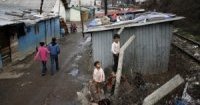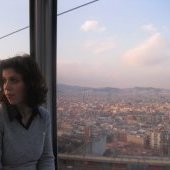Before the war, about 8000 Roma lived in a quarter of the periphery of Mitrovica called “Roma Mahalla”. The destruction of their houses and the persecutions during the conflicts forced most of them to flee abroad. A thousand Roma however, stayed in the area and in the early 2000s had to settle in makeshift camps: Cesmin Lug, Žitkovac and Kablar.
Mitrovica and its region historically draw much of their economic development from the Trepča mining complex. The lead, arsenic and cadmium emissions that come from it have brought, over the years, a very high level of air and land pollution. Yet two of the Roma camps were built only a few hundred meters away from this complex.
The consequences are dreadful. Lead is very toxic and quickly enters the blood, the muscles, and in case of long term exposure, the bones and teeth. In that case, it can take the body up to thirty years to eliminate it. It causes cerebral sequelae, damages the nervous and reproductive systems, and, in children, provokes a delay in mental and physical development. Children are particularly affected, as they absorb important quantities of lead through outdoor games, contaminated food and breast-feeding. The mortality rate in these camps is much higher than normal.
Kosovo Roma in a Sanitary Crisis
Only in 2004 did the Kosovan authorities and the United Nations close the camps of Žitkovac and Kablar. The inhabitants were transferred the following year to another camp which was deemed “healthier”, in Osterode. This camp however, is situated near Cesmin Lug and presents the same health risks. In both camps, the Roma population is still exposed to lead, arsenic and cadmium. Moreover, no controls or global treatments have been carried out in these camps. Only now is the warning cry issued by the Kosovan and international associations network starting to be heard. A large-scale European and American project is planning the rebuilding of the historical “Roma Mahalla” quarter and the progressive closing of the camps.
The Romani people’s disastrous sanitary situation has to be understood in the more global setting of their integration in Kosovan society. Although their social and political rights are recognised as those of a “national minority” by the Constitution of 2008, they are in reality widely marginalised and strongly discriminated in all levels of society (education, work, etc.).
To that you may add the de facto partition of the country: the Mitrovica area, where the camps are, is still under informal control from Belgrade. The Republic of Serbia, via granting, supports the Roma community, who does not have the same guarantees from Pristina. The Roma population finds itself, once more, a side victim of the Kosovan political game.



Follow the comments: |
|
